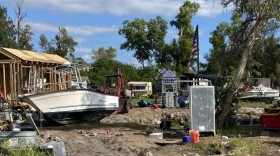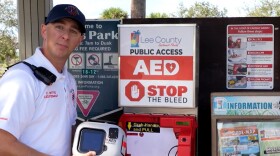Hurricane Ian wrecked Southwest Florida in late 2022, and among the devastation were the major fishing piers in Collier and Lee counties.
It was certainly a complete bummer for the landlubbers who frequented the structures angling for that night’s dinner.
But, for pelicans and other shorebirds, however, that storm erasure of the piers let them enjoy the absence of anglers, all those sharp fish hooks, and fishing line the pelicans can’t see or break.
It is hard to imagine that a mega-storm like Ian had a silver lining.
Just before landfall in Lee County on Sept. 28, 2022, Ian's maximum winds were around 150 mph, making it one of the strongest hurricanes to strike the region. It pushed churning storm surge as high as 18 feet onto land, killed at least 66 people in Florida, mostly in Lee County, and destroyed or severely damaged tens of thousands of structures.

The total cost of the storm in terms of damage and economic impact was estimated to be around $113 billion, making Ian one of the costliest hurricanes in U.S. history.
The piers extending from Naples, Fort Myers Beach, and Sanibel Island beaches were three structures it ripped to pieces.
The piers were popular with locals and tourists, and their destruction is weaved into the fabric of devastation that includes the economic impact and the recreational and tourism aspects.

However, for pelican and seabird advocates, the destruction of the piers in Collier and Lee counties provided one of the few silver linings surrounding Ian's legacy: The number of pelicans and other shorebirds with hooks in their pouches or stomachs, or fishing line wrapped tight around legs, wings or beaks dropped by 58 percent across the region.
“It was heartbreaking to witness not just the destruction of the Naples pier but the widespread devastation throughout Southwest Florida,” said Joanna Fitzgerald, director of the von Arx Wildlife Hospital. “However, in the wake of such destruction, we noticed a drop in pelicans with fishing hook and line injuries. That gave a small comfort for this team that is very dedicated to wildlife care.”
Fitzgerald hopes as the building back continues and the affected communities reflect on Hurricane Ian’s aftermath, what will remain is the heightened awareness of the delicate balance between urban structures and the surrounding environment and the animals who call it home, too.

The number of injured pelicans brought to von Ark had been increasing from 152 between October 2020 and September 2002; to 169 during the next 12 months.
Then Hurricane Ian brought its destruction. Few saw a pelican or shorebird on Sanibel or Captiva islands for weeks afterward.
During the following 11 months, only 71 injured pelicans were brought to the Naples-based wildlife hospital.
With the Fort Myers Beach and Sanibel Island piers destroyed, the staff at the Clinic for the Rehabilitation of Wildlife on Sanibel Island also treated 58 percent fewer animals laden with fishing hooks or tangled in fishing line. Although their figures count all creatures, a majority were pelicans and other shorebirds.
Hurricane Ian did not do any major damage to the fishing piers in Tampa Bay, ones that were once lanes of the Sunshine Skyway until the freighter MV Summit Venture collided with the bridge in 1980.
It was during a severe thunderstorm, and as a result of the collision, a section of the bridge collapsed causing vehicles to plunge into Tampa Bay killing 35 people.
Fishing on the old spans is popular. However, the debate between fishing folks and pelican activists has become heated in recent years as the number of animals entangled in fishing gear has been increasing.
The conflict between anglers and pelican advocates is intensifying as both sides seek to find a balance between human recreation and wildlife conservation. Concessions are in place.
Robin Jenkins, veterinarian at the Peace River Wildlife Center based in Punta Gorda south of Tampa Bay, said Hurricane Ian didn’t change the number of pelicans and other birds being brought in for treatment — but the controversy itself has.
“We don't have a whole lot of pier fishermen,” she said of Punta Gorda. “What we do get are a lot of pelicans and other shore birds -- but most predominantly pelicans -- from the Skyway Bridge. They bring a lot of their birds to us.”
Jenkins said she doesn’t know if the new rules at Skyway in response to the controversy have done anything to keep more pelicans from getting hooked.
That her Punta Gorda animal hospital receives birds from Skyway may only be because one of the key volunteers who travels to get injured birds from Tampa Bay lives nearby in Charlotte County so Jenkins’ hospital is the logical place to drop them off.
“When they first enacted those rules, they didn't bring us any at all for a while, and then they started bringing them to us again,” Jenkins said of pelicans fouled in fishing tackle. “So I'm not really sure what the difference is, or what happened.”

On Sanibel Island at the CROW animal hospital, 188 marine animals were brought in with fishing tackle injuries during the year ending in May 2021. During the next 12 months, the injury total was 147.
In the May-to-May period in which Ian struck the number of injured wildlife dropped to 62. From May of 2023 until now 83 animals have been treated for fishing-related injuries.
“It's important for everyone to be cognizant when they're fishing to make sure that monofilament lines and hooks aren't left out in the environment,” Allison Charney Hussey, CROW’s director, said. “Monofilament can be a death sentence to our wildlife.”
Sign up for WGCU's monthly environmental newsletter, the Green Flash, today.
WGCU is your trusted source for news and information in Southwest Florida. We are a nonprofit public service, and your support is more critical than ever. Keep public media strong and donate now. Thank you.







